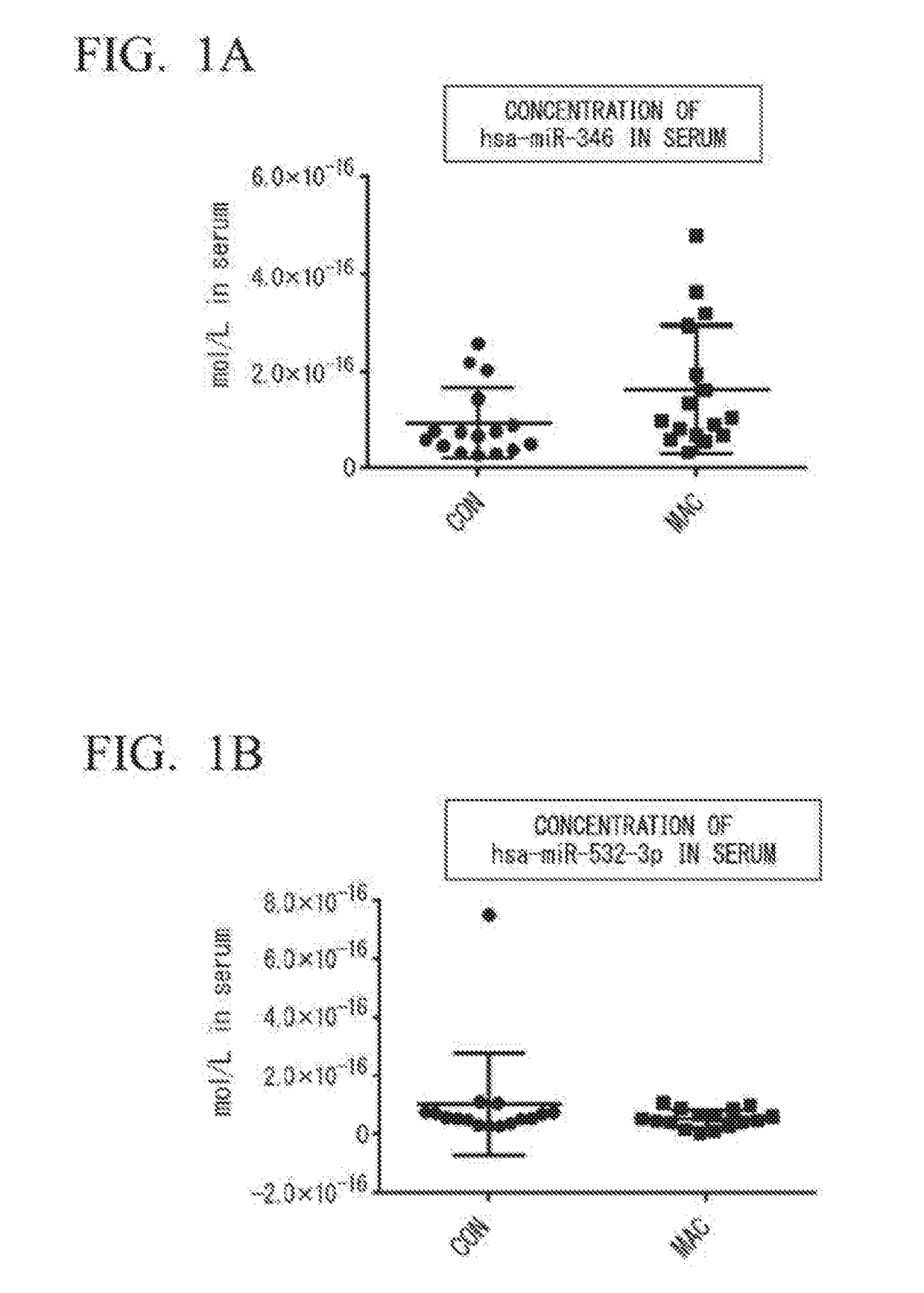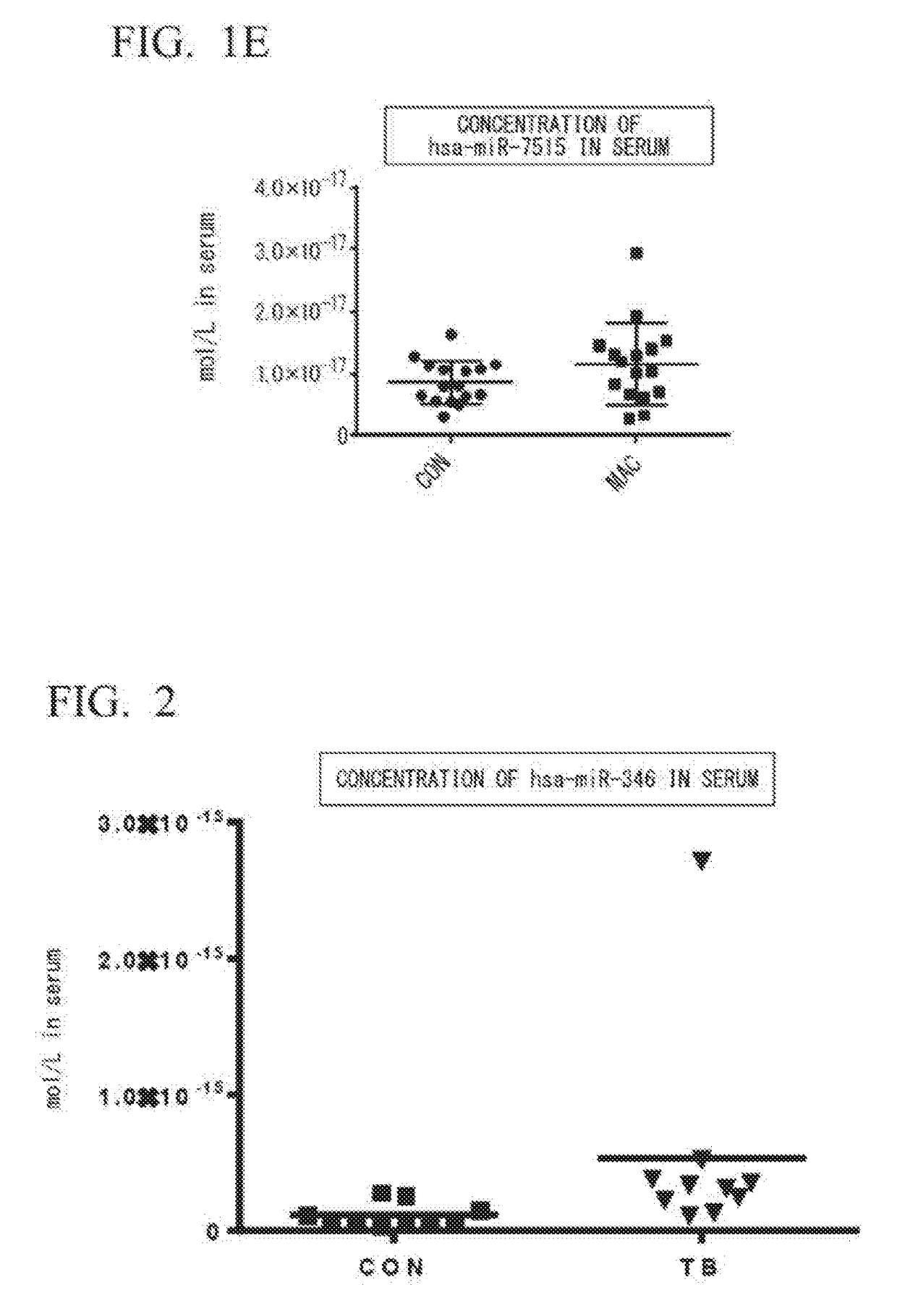Biomarker of mycobacteriosis or mycobacterial infection
a biomarker and mycobacterial technology, applied in the field of biomarkers of mycobacteriosis or mycobacterial infection, can solve the problems of sudden death, recurrence or relapse of disease, and inability to define the pathology and effective treatment methods of ntm
- Summary
- Abstract
- Description
- Claims
- Application Information
AI Technical Summary
Benefits of technology
Problems solved by technology
Method used
Image
Examples
example 1
[0078](1) Selection of Specimens
[0079]Sixteen for each group of untreated female patients diagnosed with MAC pulmonary disease (patient group: MAC) and female healthy subjects (healthy subject group: CON) were selected, and it was confirmed that there was no statistical difference between the two groups, and that the groups were matched for ages and BMI.
[0080](2) Extraction of miRNA from Serum
[0081]Blood was taken from the MAC group or the CON group selected in (1) to obtain serum. From the resulting serum, miRNA was extracted using a NucleoSpin™ miRNA plasma (manufactured by Macherey-Nagel). As an extrinsic control, cel-miR-39 (100 fmol) was added. From 300 μL of the serum, 35 μL of miRNA extract eluted with RNase-free water was obtained.
[0082](3) Synthesis of cDNA
[0083]Complementary DNA (cDNA) was synthesized by reverse transcription using the miRNA extract obtained in (2) and a TaqMan™ MicroRNA reverse Transcription Kit (manufactured by Applied Biosystems by ThermoFisher Scientif...
example 2
[0087](1) Selection of Specimens
[0088]Ten for each group of untreated patients diagnosed with tuberculosis (patient group: TB) and healthy subjects (healthy subject group: CON) were selected, and it was confirmed that there was no statistical difference between the two groups, and that the groups were matched for ages and BMI.
[0089](2) Extraction of miRNA from Serum
[0090]Blood was taken from the MAC group or the CON group selected in (1) to obtain serum. From the resulting serum, an miRNA extract was obtained by the method as described in Example 1(2).
[0091](3) Synthesis of cDNA
[0092]Complementary DNA (cDNA) was synthesized using the miRNA extract obtained in (2) and the method as described in Example 1(3).
[0093](4) Real-Time PCR
[0094]By using 1.33 μL of the reverse transcription reaction solution obtained in (3), hsa-miR-346 was quantified by a method similar to that described in Example 1(4). The results are shown in FIG. 2.
[0095]FIG. 2 shows that, in the TB group, the concentrati...
example 3
[0096](1) Cell Culture
[0097]Human peripheral blood mononuclear cell (PBMC)-derived macrophages were cultured to confluence in a 6-well plate. As a medium, Iscove's Modified Dulbecco's Media (IMDM) (manufactured by ThermoFisher Scientific Co., Ltd.) was used.
[0098](2) MAC Infection
[0099]The macrophages cultured in (1) were infected with MAC104 at a multiplicity of infection (MOI) of 50, and cultured at 37° C. for 4 hours. As a control, non-infected cells were prepared.
[0100](3) Quantification of miRNA
[0101]Subsequently, the cells were washed with PBS three times, the medium was replaced with 600 μL of IMDM (serum-free), and the cells were cultured at 37° C. therein. After 24 hours, quantification of hsa-miR-346 in 300 μL of a cell supernatant was carried out. For quantification, miRNA extraction, cDNA synthesis and real-time PCR were carried out by the methods described in Examples 1(2) to (4). The results are shown in FIG. 3.
[0102]In FIG. 3, it was seen that, in MAC-infected cells, ...
PUM
| Property | Measurement | Unit |
|---|---|---|
| temperature | aaaaa | aaaaa |
| temperature | aaaaa | aaaaa |
| excitation wavelength | aaaaa | aaaaa |
Abstract
Description
Claims
Application Information
 Login to View More
Login to View More - R&D
- Intellectual Property
- Life Sciences
- Materials
- Tech Scout
- Unparalleled Data Quality
- Higher Quality Content
- 60% Fewer Hallucinations
Browse by: Latest US Patents, China's latest patents, Technical Efficacy Thesaurus, Application Domain, Technology Topic, Popular Technical Reports.
© 2025 PatSnap. All rights reserved.Legal|Privacy policy|Modern Slavery Act Transparency Statement|Sitemap|About US| Contact US: help@patsnap.com



